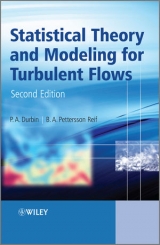
Statistical Theory and Modeling for Turbulent Flows
Seiten
2001
John Wiley & Sons Ltd (Verlag)
978-0-471-49744-8 (ISBN)
John Wiley & Sons Ltd (Verlag)
978-0-471-49744-8 (ISBN)
- Titel erscheint in neuer Auflage
- Artikel merken
Zu diesem Artikel existiert eine Nachauflage
Offers an understanding of turbulence - an area of scientific research and application - by developing both the physical insight and the mathematical framework needed to express the theory.
Most natural and industrial flows are turbulent. The atmosphere and oceans, automobile and aircraft engines, all provide examples of this ubiquitous phenomenon. In recent years, turbulence has become a very lively area of scientific research and application, and this work offers a grounding in the subject of turbulence, developing both the physical insight and the mathematical framework needed to express the theory. Providing a solid foundation in the key topics in turbulence, this valuable reference resource enables the reader to become a knowledgeable developer of predictive tools. This central and broad ranging topic would be of interest to graduate students in a broad range of subjects, including aeronautical and mechanical engineering, applied mathematics and the physical sciences. The accompanying solutions manual to the text also makes this a valuable teaching tool for lecturers and for practising engineers and scientists in computational and experimental and experimental fluid dynamics.
Most natural and industrial flows are turbulent. The atmosphere and oceans, automobile and aircraft engines, all provide examples of this ubiquitous phenomenon. In recent years, turbulence has become a very lively area of scientific research and application, and this work offers a grounding in the subject of turbulence, developing both the physical insight and the mathematical framework needed to express the theory. Providing a solid foundation in the key topics in turbulence, this valuable reference resource enables the reader to become a knowledgeable developer of predictive tools. This central and broad ranging topic would be of interest to graduate students in a broad range of subjects, including aeronautical and mechanical engineering, applied mathematics and the physical sciences. The accompanying solutions manual to the text also makes this a valuable teaching tool for lecturers and for practising engineers and scientists in computational and experimental and experimental fluid dynamics.
Preface. Motivation. Epitome. Acknowledgments. FUNDAMENTALS OF TURBULENCE. Introduction. Mathematical and Statistical Background. Reynolds Averaged Navier--Stokes Equations. Parallel and Self--Similar Shear Flows. Vorticity and Vortical Structures. SINGLE POINT CLOSURE MODELING. Models with Scalar Variables. Models with Tensor Variables. Advanced Topics. THEORY OF HOMOGENEOUS TURBULENCE. Mathematical Representations. Navier--Stokes Equations in Spectral Space. Rapid Distortion Theory. References. Index.
| Erscheint lt. Verlag | 23.1.2001 |
|---|---|
| Zusatzinfo | Illustrations |
| Verlagsort | Chichester |
| Sprache | englisch |
| Maße | 169 x 246 mm |
| Gewicht | 510 g |
| Einbandart | Paperback |
| Themenwelt | Mathematik / Informatik ► Mathematik ► Angewandte Mathematik |
| Technik ► Fahrzeugbau / Schiffbau | |
| Technik ► Luft- / Raumfahrttechnik | |
| Technik ► Maschinenbau | |
| ISBN-10 | 0-471-49744-4 / 0471497444 |
| ISBN-13 | 978-0-471-49744-8 / 9780471497448 |
| Zustand | Neuware |
| Informationen gemäß Produktsicherheitsverordnung (GPSR) | |
| Haben Sie eine Frage zum Produkt? |
Mehr entdecken
aus dem Bereich
aus dem Bereich
für Ingenieure und Naturwissenschaftler
Buch | Softcover (2024)
Springer Vieweg (Verlag)
CHF 48,95
Buch | Softcover (2025)
Springer Vieweg (Verlag)
CHF 62,95
Buch | Softcover (2025)
Springer Fachmedien Wiesbaden (Verlag)
CHF 69,95



